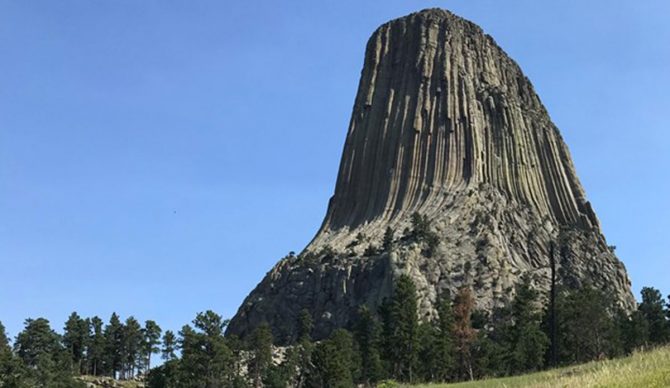
Devils Tower has claimed the life of a young climber who fell while rappelling. Photo: NPS
A rock climber has died after a fall from Devils Tower National Monument in Wyoming.
According to reports, Stewart Phillip Porter, the 21-year-old victim, was climbing the famous butte just before 8 p.m. on Sunday. He was rappelling down the second pitch of El Cracko when he fell, sustaining “major injuries.” Devils Tower authorities were called, but sadly, when they arrived on scene at 8:40 p.m., Porter was beyond saving.
Porter was climbing with a partner who needed to be rescued from the wall of the Tower.
“While climbing fatalities at Devils Tower are infrequent,” the National Park Service wrote (there have been seven in the last 100 years), “it is still inherently dangerous.”
Devils Tower was once called Bear Lodge. Native Americans in the area had multiple names for it, including Grey Horn Butte, Tree Rock, and The Place Where Bears Live. In the early 1900s, Colonel Richard Irving Dodge sent an expedition to study the formation, and he wrote that “the Indians call this place ‘bad god’s tower.” And so the name Devil’s Tower was born. The U.S. Board on Geographic Names, however, doesn’t like to use possessive apostrophes, so the name was officially changed to Devils Tower.
In the wake of Porter’s death, the National Park Service reminded the public of how important taking the proper safety measures is if you’re climbing.
“Check the local weather forecast before climbing and observe changing weather conditions,” officials said. “Watch for animals (stinging insects, birds, rodents and reptiles all live on the Tower) … [and] Consult multiple sources for information on a route, as suggested gear varies between guidebooks.”
According to Park officials, the majority of climbing accidents at Devils Tower happen while rappelling.
“The National Park Service does not maintain anchors – inspect all anchors and back them up if necessary,” officials wrote. “Ensure you know the location of your rappel route before you begin. Start rappels over the nose of columns to prevent ropes from jamming in cracks. Avoid knocking loose rock onto climbers below. Many rappels require two ropes; know the distance of your planned rappel before beginning.”

